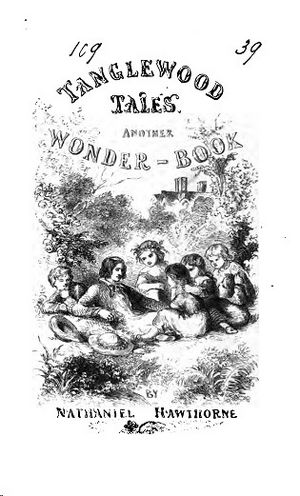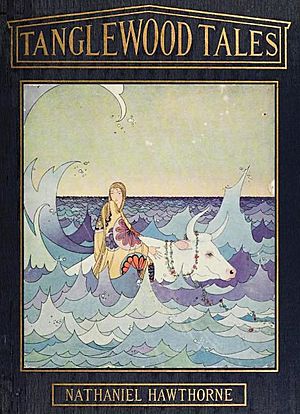Tanglewood Tales facts for kids
Tanglewood Tales for Boys and Girls is a book written by American author Nathaniel Hawthorne. It was published in 1853. This book is a follow-up to his earlier work, A Wonder-Book for Girls and Boys. In Tanglewood Tales, Hawthorne retells famous Greek myths in a way that is easy for children to understand and enjoy.
Contents
What Greek Myths Are in the Book?
This book shares exciting stories from ancient Greek myths. Each story is a chapter in the book.
- Theseus and the Minotaur: This chapter is called "The Minotaur." It tells the tale of a brave hero and a monster.
- Antaeus and the Pygmies: You can find this story in the chapter "The Pygmies." It's about a giant and tiny people.
- Dragon's Teeth: The chapter "The Dragon's Teeth" tells how a hero faced a dragon.
- Circe's Palace: This story, "Circe's Palace," is about a powerful sorceress.
- Proserpina, Ceres, Pluto, and the Pomegranate Seed: In "The Pomegranate Seed," you'll learn about the seasons.
- Jason and the Golden Fleece: The chapter "The Golden Fleece" follows a hero on a quest for a magical item.
Why Did Nathaniel Hawthorne Write These Tales?
Hawthorne wrote an introduction to the book called "The Wayside." This name comes from The Wayside house in Concord. He lived there from 1852 until he passed away.
In this introduction, Hawthorne explains why he wrote the book. A young friend named Eustace Bright visited him. Eustace asked for more stories like those in A Wonder-Book. This request inspired Hawthorne to write Tanglewood Tales.
How Did "Tanglewood" Get Its Name?
Nathaniel Hawthorne wrote his first book of myths while staying in a small house. This house was in the Berkshires, a beautiful area in Massachusetts. Wealthy people often vacationed there.
The owner of the house was a rich businessman. He loved Hawthorne's book so much that he renamed the cottage "Tanglewood." He did this to honor the book written there. Later, a large house nearby was also named Tanglewood. This place became famous for outdoor classical music concerts. These concerts are now a summer tradition in the Berkshires.
Interestingly, Hawthorne did not enjoy living in the Berkshires very much.
Places Named After the Book
The book Tanglewood Tales became quite popular. It even inspired the names of other places.
- The Tanglewood neighborhood in Houston, Texas, was named after the book. Mary Catherine Farrington, whose father developed the area, loved the book.
- It is also believed that the thickly wooded Tanglewood Island in Washington state got its name from the book.



